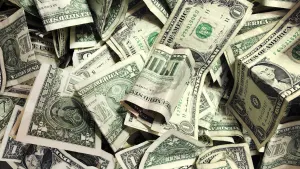Here's what the Fed interest rate hike means for you
The Federal Reserve raised its key rate by a quarter point Wednesday, bringing it to the highest level in 15 years.
Share:
More Stories
0:24

U-Haul smashes through fence in Westfield, driver rescued
3h ago2:13

Made in NJ: Paver Art in Lindenwold
3h ago1:43

The Cost Of: Fall weddings
4h ago0:26

Macy's reveals new balloons for Thanksgiving Day Parade
4h ago2:24

'Stock the Shelves' program helps Union County residents hit by losing SNAP
5h ago2:03

Open Enrollment begins for Medicare: Dr. Oz tells you what you need to know
5h ago0:24

U-Haul smashes through fence in Westfield, driver rescued
3h ago2:13

Made in NJ: Paver Art in Lindenwold
3h ago1:43

The Cost Of: Fall weddings
4h ago0:26

Macy's reveals new balloons for Thanksgiving Day Parade
4h ago2:24

'Stock the Shelves' program helps Union County residents hit by losing SNAP
5h ago2:03

Open Enrollment begins for Medicare: Dr. Oz tells you what you need to know
5h agoThe Federal Reserve raised its key rate by a quarter point Wednesday, bringing it to the highest level in 15 years as part of an ongoing effort to ease inflation by making borrowing more expensive.
The rate increase will likely make it even costlier to borrow for homes, autos and other purchases. But if you have money to save, you’ll probably earn a bit more interest on it.
The latest rate increase is smaller than the Fed's half-point rate hike in December and its four straight three-quarter-point increases earlier last year. The slowdown reflects the fact that inflation, while still high, is easing, and some parts of the economy seem to be cooling.
But it's still an increase, to a range of 4.5% to 4.75%. And many economists say they still fear that a recession remains possible — and with it, job losses that could cause hardship for households already hurt by inflation.
Here's what to know:
WHAT’S PROMPTING THE RATE INCREASES?
The short answer: Inflation. Over the past year, consumer inflation in the United States has clocked in at 6.5% — a figure that reflects a sixth straight monthly slowdown but still uncomfortably high.
The Fed’s goal is to slow consumer spending, thereby reducing demand for homes, cars and other goods and services, eventually cooling the economy and lowering prices.
Fed Chair Jerome Powell has acknowledged in the past that aggressively raising rates would bring “some pain” for households but said that doing so is necessary to crush high inflation.
WHICH CONSUMERS ARE MOST AFFECTED?
Anyone borrowing money to make a large purchase, such as a home, car or large appliance, will likely take a hit. The new rate will also increase monthly payments and costs for any consumer who is already paying interest on credit card debt.
“It's already been a really rough year with folks with credit card debt, and it's only going to get worse,” said credit analyst Matt Schulz of LendingTree. “The immediacy of the increase is what's hard — that it affects not just future purchases but current balances.”
That said, Scott Hoyt, an analyst with Moody's Analytics, noted that household debt payments, as a proportion of income, remain relatively low, though they have risen lately. So even as borrowing rates steadily rise, many households might not feel a much heavier debt burden immediately.
HOW WILL THIS AFFECT CREDIT CARD RATES?
Even before the Fed’s latest move, credit card borrowing rates had reached their highest level since 1996, according to Bankrate.com, and these will likely continue to rise.
There are also signs that Americans are increasingly relying on credit cards to help maintain their spending. Total credit card balances have topped $900 billion, according to the Fed, a record high, though that amount isn’t adjusted for inflation.
“Right now, most people may have jobs and rising incomes, but they're looking to the horizon and seeing storm clouds start to build,” said Nationwide Senior Economist Ben Ayers. “It's really an inflection point for the economy.”
As rates have risen, zero percent loans marketed as “Buy Now, Pay Later” have become popular with consumers. But longer-term loans of more than four payments that these companies offer are subject to the same increased borrowing rates as credit cards.
For those who don’t qualify for low-rate credit cards because of weak credit scores, the higher interest rates are already affecting their balances.
John Leer, chief economist at Morning Consult, a survey research firm, said its polling suggests that more Americans are spending down the savings they accumulated during the pandemic and are using credit instead. Eventually, rising rates could make it harder for those households to pay off their debts.
For those who have home equity lines of credit or other variable-interest debt, rates will increase by roughly the same amount as the Fed hike, usually within one or two billing cycles. That’s because those rates are based in part on banks’ prime rate, which follow the Fed’s.
HOW ARE SAVERS AFFECTED?
The rising returns on high-yield savings accounts and certificates of deposit (CDs) have put them at levels not seen since 2009, which means that households may want to boost savings if possible. You can also now earn more on bonds and other fixed-income investments.
Though savings, CDs, and money market accounts don’t typically track the Fed’s changes, online banks and others that offer high-yield savings accounts can be exceptions. These institutions typically compete aggressively for depositors. (The catch: They sometimes require significantly high deposits.)
In general, banks tend to capitalize on a higher-rate environment to boost their profits by imposing higher rates on borrowers, without necessarily offering juicer rates to savers.
WILL THIS AFFECT HOME OWNERSHIP?
Last week, mortgage buyer Freddie Mac reported that the average rate on the benchmark 30-year mortgage dipped to 6.13% from 6.15% the week prior. A year ago, the average rate was much lower: 3.55%. That means the rate on a typical home loan is still almost twice as expensive as it was a year ago.
Mortgage rates don’t always move in tandem with the Fed’s benchmark rate. They instead tend to track the yield on the 10-year Treasury note.
Sales of existing homes have declined for 11 straight months as borrowing costs have become too high a hurdle for many Americans who are already paying much more for food, gas and other necessities.
WILL IT BE EASIER TO FIND A HOUSE IF I’M STILL LOOKING TO BUY?
If you’re financially able to proceed with a home purchase, you’re likely to have more options now.
WHAT IF I WANT TO BUY A CAR?
With shortages of computer chips and other parts easing, automakers are producing more vehicles. Many are even reducing prices or offering limited discounts. But rising loan rates and lower used-vehicle trade-in values have erased much of the savings on monthly payments.
“With the interest that you’re going to pay, those payments might not look too dissimilar to what they were a few months ago,” said Ivan Drury, director of insights for Edmunds.com. “It’s like every single time we hear one piece of good news, it’s being offset by pieces of bad news.”
Since the Fed began raising rates in March, the average new vehicle loan has jumped from 4.5% to 6.9%, according to Edmunds data. Used vehicle loans are up 2.5 percentage points to 10.6%. Loan durations are averaging roughly 70 months — nearly six years — for both new and used vehicles.
Edmunds says that since March, monthly payments have risen by an average of $71 to $728 for new vehicles. For used vehicles, it's up just $3 a month to $546.
Financing a new vehicle, with an average price of $48,516 as of December, now costs $8,769 in interest, Drury said. That’s enough to chase many out of the auto market.
Any Fed rate increase is typically passed through to auto borrowers, though it will be slightly offset by subsidized rates from manufacturers.
HOW HAVE THE RATE HIKES INFLUENCED CRYPTO?
Cryptocurrencies like bitcoin have dropped in value since the Fed began raising rates. So have many previously high-valued technology stocks.
Higher rates mean that safe assets like Treasuries become more attractive to investors because their yields have increased. That makes risky assets like technology stocks and cryptocurrencies less attractive.
Still, bitcoin continues to suffer from problems separate from economic policy. Three major crypto firms have failed, most recently the high-profile FTX exchange, shaking the confidence of crypto investors.
WHAT ABOUT MY JOB?
The nation’s employers kept hiring in December, adding a healthy 223,000 jobs. The unemployment rate fell from 3.6% to 3.5%, matching a 53-year low. At the same time, the jobs gain was the smallest in two months, suggesting a slowdown, with pay growth also easing.
“Things are moderating and slowing down, but the labor market is still relatively strong,” said Nick Bunker, Economic Research Director at hiring site Indeed. “One of the reasons the Fed continues to raise rates is that it thinks the labor market is too strong.”
Some economists argue that layoffs could slow rising prices, and that a tight labor market fuels wage growth and higher inflation.
While layoffs are now historically low, there's also the possibility there will simply be fewer job openings in coming months.
“I think a lot of the hikes are behind us,” Bunker said. “But there's the potential the labor market is going to deteriorate for some people, so people should be alert to a continued slowdown.”
WILL THIS AFFECT STUDENT LOANS?
Borrowers who take out new private student loans should prepare to pay more as as rates increase. The current range for federal loans is between about 5% and 7.5%.
That said, payments on federal student loans are suspended with zero interest until summer 2023 as part of an emergency measure put in place early in the pandemic. President Joe Biden has also announced some loan forgiveness, of up to $10,000 for most borrowers, and up to $20,000 for Pell Grant recipients — a policy that’s now being challenged in the courts.
MORE: Getting ready to apply to college this year? This is what you need to know about student loans.
IS THERE A CHANCE THE RATE HIKES WILL BE REVERSED?
It looks increasingly unlikely that rates will come down anytime soon.
“We're expecting inflation will still be too hot for the Fed even by the end of the year,” said Nationwide's Ayers. “We predict it won't be until next year that they begin to lower rates.”
More from News 12
1:34

The Real Deal: How to beat inflation with a summer spending plan
1:44

The Real Deal: Betting trends for the Empire State
1:48

The Real Deal: Summer travel trends and how to save money on your next vacation
3:31

Guide: Ways to set your child up for financial success
1:34

The Real Deal: The best deals for mom this Mother’s Day
3:13
